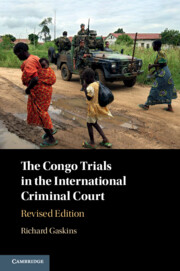53 results
2 - Balancing Politics, Morality, and Culture
- from Testing A New Court
-
- Book:
- The Congo Trials in the International Criminal Court
- Published online:
- 26 May 2022
- Print publication:
- 26 May 2022, pp 29-60
-
- Chapter
- Export citation
Acknowledgments
-
- Book:
- The Congo Trials in the International Criminal Court
- Published online:
- 26 May 2022
- Print publication:
- 26 May 2022, pp viii-x
-
- Chapter
- Export citation

The Congo Trials in the International Criminal Court
-
- Published online:
- 26 May 2022
- Print publication:
- 26 May 2022
5 - Battling Impunity in Ituri
- from The Bridge to the Hague
-
- Book:
- The Congo Trials in the International Criminal Court
- Published online:
- 26 May 2022
- Print publication:
- 26 May 2022, pp 131-161
-
- Chapter
- Export citation
Testing A New Court
-
- Book:
- The Congo Trials in the International Criminal Court
- Published online:
- 26 May 2022
- Print publication:
- 26 May 2022, pp 5-60
-
- Chapter
- Export citation
A Laboratory for Global Justice
-
- Book:
- The Congo Trials in the International Criminal Court
- Published online:
- 26 May 2022
- Print publication:
- 26 May 2022, pp 1-4
-
- Chapter
- Export citation
9 - The Trial of Jean-Pierre Bemba
- from The Congo Trials
-
- Book:
- The Congo Trials in the International Criminal Court
- Published online:
- 26 May 2022
- Print publication:
- 26 May 2022, pp 375-447
-
- Chapter
- Export citation
1 - Spreading Justice to Distant Conflicts
- from Testing A New Court
-
- Book:
- The Congo Trials in the International Criminal Court
- Published online:
- 26 May 2022
- Print publication:
- 26 May 2022, pp 7-28
-
- Chapter
- Export citation
The Bridge to the Hague
-
- Book:
- The Congo Trials in the International Criminal Court
- Published online:
- 26 May 2022
- Print publication:
- 26 May 2022, pp 129-206
-
- Chapter
- Export citation
Dedication
-
- Book:
- The Congo Trials in the International Criminal Court
- Published online:
- 26 May 2022
- Print publication:
- 26 May 2022, pp v-v
-
- Chapter
- Export citation
Copyright page
-
- Book:
- The Congo Trials in the International Criminal Court
- Published online:
- 26 May 2022
- Print publication:
- 26 May 2022, pp iv-iv
-
- Chapter
- Export citation
Postscript
- from The Congo Trials
-
- Book:
- The Congo Trials in the International Criminal Court
- Published online:
- 26 May 2022
- Print publication:
- 26 May 2022, pp 456-475
-
- Chapter
- Export citation
Epigraph
-
- Book:
- The Congo Trials in the International Criminal Court
- Published online:
- 26 May 2022
- Print publication:
- 26 May 2022, pp vi-vi
-
- Chapter
- Export citation
7 - The Trial of Thomas Lubanga
- from The Congo Trials
-
- Book:
- The Congo Trials in the International Criminal Court
- Published online:
- 26 May 2022
- Print publication:
- 26 May 2022, pp 211-290
-
- Chapter
- Export citation
6 - ICC Structures, Dynamics, Tensions
- from The Bridge to the Hague
-
- Book:
- The Congo Trials in the International Criminal Court
- Published online:
- 26 May 2022
- Print publication:
- 26 May 2022, pp 162-206
-
- Chapter
- Export citation
Index
-
- Book:
- The Congo Trials in the International Criminal Court
- Published online:
- 26 May 2022
- Print publication:
- 26 May 2022, pp 476-483
-
- Chapter
- Export citation
Observations
- from The Congo Trials
-
- Book:
- The Congo Trials in the International Criminal Court
- Published online:
- 26 May 2022
- Print publication:
- 26 May 2022, pp 448-455
-
- Chapter
- Export citation
8 - The Trial of Germain Katanga and Mathieu Ngudjolo
- from The Congo Trials
-
- Book:
- The Congo Trials in the International Criminal Court
- Published online:
- 26 May 2022
- Print publication:
- 26 May 2022, pp 291-374
-
- Chapter
- Export citation
4 - Structures of Local Conflict: The Micro View
- from Back in Ituri
-
- Book:
- The Congo Trials in the International Criminal Court
- Published online:
- 26 May 2022
- Print publication:
- 26 May 2022, pp 93-128
-
- Chapter
- Export citation
3 - Ituri in the Web of Chaos: The Macro View
- from Back in Ituri
-
- Book:
- The Congo Trials in the International Criminal Court
- Published online:
- 26 May 2022
- Print publication:
- 26 May 2022, pp 65-92
-
- Chapter
- Export citation



